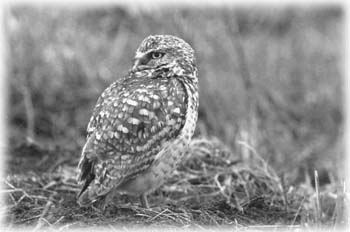![[Metroactive Features]](http://metroactive.com/features/gifs/feat468.gif)
![[Metroactive Features]](http://metroactive.com/features/gifs/feat468.gif)
[ Summer Index | Metro | Metroactive Central | Archives ]
Hole Truth
Athene Cunicularia
By Will Harper
THEY'RE NOT CLASSIFIED as an endangered species yet, but burrowing owls make their underground homes in prime building real estate: open grasslands near the valley floor. As a result, says ecologist Lynne Trulio, an assistant professor at San Jose State University, the Bay Area's burrowing owl population has dropped by half over the past decade. Trulio estimates that about 350 remain in the region, from Gilroy in the south, up to Palo Alto and over to Hayward.
Historically, local naturalists referred to them as a common sight in the valley.
Burrowing owls are a native California bird that stands about 9 inches tall, resembling, as one Audubon spokesperson put it, a miniature owl on stilts. They are the only owls that live underground. Not equipped to dig, they are nature's adorable freeloaders, squatters in vacant burrows left by ground squirrels. Though she's been unable to prove it scientifically, Trulio suspects that ground squirrels and owls have a friendly, symbiotic relationship, possibly relying on each other's warning calls when a predator approaches.
The California Dept. of Fish and Game has designated them a "species of special concern," just a notch above being considered endangered. Despite their decline, the owls have been able to adapt reasonably well to urbanization as long as they have room to forage for insects and small rodents. Active during the day and night, the laid-back birds can often be spotted hanging out in front of their burrows checking out their surroundings, which now include passing cars and screaming schoolkids.
Local government agencies in the South Bay have just started to discuss crafting a regional habitat-conservation plan to mitigate further destruction of owl habitats by creeping urban development. State law already requires developers who find burrowing owls on their land to either set aside room for them or relocate them.
Because of high land prices in the area, developers are understandably reluctant to set aside valuable real estate.
Relocation, however, isn't easy, because for one thing the owls are valley dwellers and can't just be moved up onto the protected hillsides. Ornithologist Scott Terrill, an environmental consultant with H.T. Harvey & Associates, says trapping and transporting the birds isn't always successful, takes a long time and costs money. According to Terrill, 3Com is spending more than $100,000 for owl habitat mitigation on a project in San Jose.
As part of the regional conservation plan, Terrill says cities are talking about setting aside land for owl habitats that would be paid for by developers. That way, Terrill says, developers will at least be able to know up front how much habitat-protection is going to cost.
[ Metro | Metroactive Central | Archives ]
This page was designed and created by the Boulevards team.

From the May 1-7, 1997 issue of Metro
Copyright © 1997 Metro Publishing, Inc.